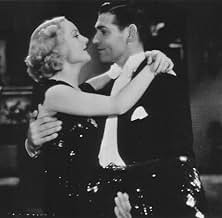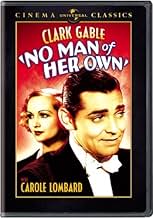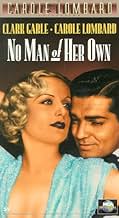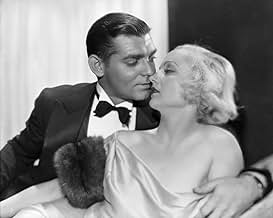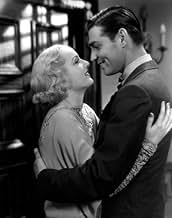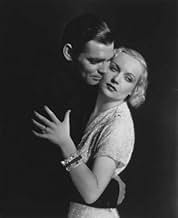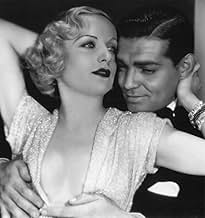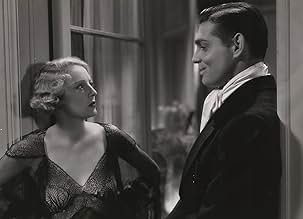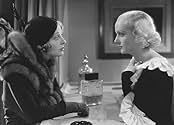AVALIAÇÃO DA IMDb
6,6/10
1,8 mil
SUA AVALIAÇÃO
Adicionar um enredo no seu idiomaAn on-the-lam New York card shark marries a small-town librarian who thinks he's a businessman.An on-the-lam New York card shark marries a small-town librarian who thinks he's a businessman.An on-the-lam New York card shark marries a small-town librarian who thinks he's a businessman.
- Direção
- Roteiristas
- Artistas
- Prêmios
- 1 vitória no total
Sammy Blum
- Door to Door Salesman
- (não creditado)
Mary Bracken
- High School Girl
- (não creditado)
Wallis Clark
- Thomas Laidlaw
- (não creditado)
Lillian Harmer
- Mattie
- (não creditado)
Margaret Marquis
- Girl in the Library
- (não creditado)
Avaliações em destaque
Good little film. Clark Gable once again plays the likable scoundrel role he does so well. This time he is Babe Stewart, a card shark who meets a small town girl (Carole Lombard), marries her on the flip of a coin, then realizes he'll have to change his ways if he wants to keep her. The script is well written, avoiding the melodramatic speeches and sappy dialogue that could have so easily been thrown into this kind of film. It also helps that the actors were able to play the characters naturally without hamming it up. Emotion is so much more believable when it's realistic. The supporting cast gives good performance as well, adding a bit of flavor to the film. A good script, good cast, and interesting enough storyline make this one worth watching.
The perks of this movie are many: a fun screwball comedy set-up involving card-sharking, two beautiful stars looking young and fantastic (you'll see why women first fell in love with Clarke Gable, and found him ideal to play Rhett Butler), the only on screen pairing of said stars, who were to become husband and wife. He would love her long after she died in a tragic plane accident on a mission to sell war bonds (i think it was). Another perk is the pre-production code raunchiness. You may notice that any movie made between 1930-1934 seems a lot racier than movies made before or after then. This is because in this short period there was no censorship of movie content, and no rules to say what you could and could not show on screen. This was left to the filmmaker's discretion. So you'll find shots of Gable in the shower, and Lombard also, though she is much less exposed. Not actual nudity, of course, but open sexiness banished from movies from 1934 till whenever the Hayes code ended - such as Gable asking Lombard the librarian to fetch him a book from the top shelf so she has to climb up the ladder and he can look at her legs.
If you've never seen a screwball comedy, you might be pleasantly surprised. They're all pretty fun. Bringing up Baby with Cary Grant and Katherine Hepburn is probably the best one. They were all the rage in the 30's, and Carole Lombard was the ideal screwball heroine. To be recommended.
If you've never seen a screwball comedy, you might be pleasantly surprised. They're all pretty fun. Bringing up Baby with Cary Grant and Katherine Hepburn is probably the best one. They were all the rage in the 30's, and Carole Lombard was the ideal screwball heroine. To be recommended.
10lora64
This is a pleasant kind of tale, easygoing and amusing. Clark Gable as the gambler Babe Stewart, meets quiet (i.e. repressed) librarian Connie Randall, played by Carole Lombard. At the library, when he corners her amongst the bookshelves, she asks, "Do you like Shakespeare?" and I like Gable's reply, "Oh Shakespeare's alright but sometimes you just don't feel like Shakespeare" says he gazing deep into her eyes. Just an amusing moment.
After a hesitant start they inevitably fall in love and impulsively decide to wed, and thereafter the plot unfolds. Gable resumes his dishonest card sniping activities (i.e. racket), however this clashes with the wifey on the domestic front. In time he plans to reform his ways, "Things gotta be different from now on," he tells the police, but there are complications ahead.
It's very interesting to see a younger Clark Gable who even at this stage was well established in his screen presence. And Carole Lombard couldn't be more beautiful! Great viewing for the fans of Gable and Lombard.
After a hesitant start they inevitably fall in love and impulsively decide to wed, and thereafter the plot unfolds. Gable resumes his dishonest card sniping activities (i.e. racket), however this clashes with the wifey on the domestic front. In time he plans to reform his ways, "Things gotta be different from now on," he tells the police, but there are complications ahead.
It's very interesting to see a younger Clark Gable who even at this stage was well established in his screen presence. And Carole Lombard couldn't be more beautiful! Great viewing for the fans of Gable and Lombard.
... and I could definitely feel the chemistry between Lombard and Gable, even if they could not at this point. But it is a rather understated affair, even dragging at times.
It starts out lively and with promise, as a group of four card sharps make a killing against a mark and divide their loot. But afterwards a cop, Collins, comes up to speak to the ringleader, Jerry Stewart (Clark Gable), and lets him know he's on to what he's doing and is watching him. Also that same night, Jerry breaks up with one of his fellow card sharps, Kay (Dorothy Mackail), and she threatens to go to the DA about their activities in retaliation. Jerry decides to leave town for awhile until the immediate heat is off and travels to the tiny hamlet of Glendale. There he meets somebody who is as bored with the place as he is, town librarian Connie Randall (Carole Lombard). Things heat up quickly between them and they impulsively marry. Jerry never told Connie what he really does for a living, letting her believe he is a stockbroker. But being a gambler is all he knows, so what now, once they are back in New York? Complications ensue.
This is not a screwball comedy with Lombard doing her trademark screwball comedienne act. Lombard is a dramatic actress at this point, and doesn't really begin to hone her comedic chops until "Twentieth Century" in 1934. Gable is the one mainly carrying any comedic weight in this film, which is something he always did well.
I'd mildly recommend it mainly to see the only screen pairing of Lombard and Gable, years before they had any romantic interest in one another.
It starts out lively and with promise, as a group of four card sharps make a killing against a mark and divide their loot. But afterwards a cop, Collins, comes up to speak to the ringleader, Jerry Stewart (Clark Gable), and lets him know he's on to what he's doing and is watching him. Also that same night, Jerry breaks up with one of his fellow card sharps, Kay (Dorothy Mackail), and she threatens to go to the DA about their activities in retaliation. Jerry decides to leave town for awhile until the immediate heat is off and travels to the tiny hamlet of Glendale. There he meets somebody who is as bored with the place as he is, town librarian Connie Randall (Carole Lombard). Things heat up quickly between them and they impulsively marry. Jerry never told Connie what he really does for a living, letting her believe he is a stockbroker. But being a gambler is all he knows, so what now, once they are back in New York? Complications ensue.
This is not a screwball comedy with Lombard doing her trademark screwball comedienne act. Lombard is a dramatic actress at this point, and doesn't really begin to hone her comedic chops until "Twentieth Century" in 1934. Gable is the one mainly carrying any comedic weight in this film, which is something he always did well.
I'd mildly recommend it mainly to see the only screen pairing of Lombard and Gable, years before they had any romantic interest in one another.
Clark Gable and his great love, Carole Lombard, only made one film together - this one, "No Man of Her Own" - and they weren't even a couple. At the time of "No Man of Her Own," Lombard was married to William Powell, and Gable to a socialite named Maria Franklin. When he fell for Lombard a few years after this movie was made, it was some time before Franklin would give him a divorce.
A mustacheless Gable plays a cheating card shark who, while on the lam, meets a librarian (Lombard) and marries her. He's not planning that it be permanent; along the way, they fall in love.
Both stars are very good and have great chemistry. She's beautiful, and he's just one sexy devil with that smile and the way he looked at a woman. Pretty devastating, with or without the mustache. A great screen presence.
Someone commented that had Lombard not died, she would have signed with MGM and been paired with Gable in more films. It would be wonderful to have them together more than once. In 1937, in fact, when Jean Harlow died during the making of "Saratoga," Gable recommended that she be replaced with Lombard. Lest anyone think that was insensitive - the situation of a star dying in the middle of a film was new to everyone, no one knew how it would be handled, and poor Gable thought he was helping. People back then didn't think in terms of leaving a legacy and last films.
So we're stuck with the pre-code "No Man of Her Own." Not bad, not great, of interest because of its two stars.
A mustacheless Gable plays a cheating card shark who, while on the lam, meets a librarian (Lombard) and marries her. He's not planning that it be permanent; along the way, they fall in love.
Both stars are very good and have great chemistry. She's beautiful, and he's just one sexy devil with that smile and the way he looked at a woman. Pretty devastating, with or without the mustache. A great screen presence.
Someone commented that had Lombard not died, she would have signed with MGM and been paired with Gable in more films. It would be wonderful to have them together more than once. In 1937, in fact, when Jean Harlow died during the making of "Saratoga," Gable recommended that she be replaced with Lombard. Lest anyone think that was insensitive - the situation of a star dying in the middle of a film was new to everyone, no one knew how it would be handled, and poor Gable thought he was helping. People back then didn't think in terms of leaving a legacy and last films.
So we're stuck with the pre-code "No Man of Her Own." Not bad, not great, of interest because of its two stars.
Você sabia?
- CuriosidadesAlthough Carole Lombard and Clark Gable later became one of Hollywood's most famous couples, they were completely indifferent to one another during the making of this film. It was not until several years later that they met again and fell in love and got married. This was Gable and Lombard's only film together.
- Erros de gravaçãoEarly in the movie, Babe takes a taxi; there is a very clear view of the front hood of the cab, with the telephone number of the cab company. Later in the movie, Babe calls his wife with his new office phone number. He looks at the dial of his new phone and gives her the telephone number of the cab company.
- Cenas durante ou pós-créditosThe cast is shown on a hand of poker cards, with the leads' faces shown as the various cards.
- ConexõesFeatured in The Love Goddesses (1965)
Principais escolhas
Faça login para avaliar e ver a lista de recomendações personalizadas
- How long is No Man of Her Own?Fornecido pela Alexa
Detalhes
- Data de lançamento
- País de origem
- Idioma
- Também conhecido como
- No Man of Her Own
- Locações de filme
- Empresa de produção
- Consulte mais créditos da empresa na IMDbPro
- Tempo de duração
- 1 h 25 min(85 min)
- Cor
- Proporção
- 1.37 : 1
Contribua para esta página
Sugerir uma alteração ou adicionar conteúdo ausente

